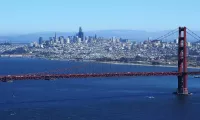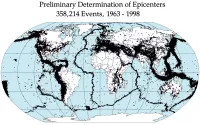The San Andreas Fault is a 1,200 km right-lateral strike-slip transform fault in California, marking the boundary between the Pacific and North American plates. It's divided into three segments with varying earthquake risks. The fault has an average slip rate of 20 to 35 mm per year.
1901: Parkfield earthquake
Seismologists recorded a magnitude 6.0 earthquake near Parkfield in central California in 1901.
1906: Northern segment earthquake
According to a 2006 study by Yuri Fialko, strong earthquakes have occurred relatively recently on the northern (1906) segments of the fault.
1906: Lawson discovered the fault extended to Southern California
Eleven years after identifying the fault in Northern California, in 1906, Lawson discovered that the San Andreas Fault stretched southward into southern California after reviewing the effects of the San Francisco earthquake.
1906: Lawson deciphered the origin of the 1906 San Francisco earthquake
In 1906, following the San Francisco earthquake, Professor Andrew Lawson surveyed and mapped offsets along surface ruptures and concluded that the fault was the origin of the earthquake.
1906: San Francisco earthquake
In 1906, the San Francisco earthquake occurred near Daly City along the northern segment of the San Andreas Fault.
1908: Lawson reports San Andreas Valley origin
According to some of his reports from 1895 and 1908, Lawson actually named the fault after the surrounding San Andreas Valley.
1922: Parkfield earthquake
Seismologists recorded a magnitude 6.0 earthquake near Parkfield in central California in 1922.
1934: Parkfield earthquake
Seismologists recorded a magnitude 6.0 earthquake near Parkfield in central California in 1934.
1953: Dibblee concluded lateral movement along the fault
In 1953, geologist Thomas Dibblee concluded that hundreds of miles of lateral movement could occur along the San Andreas Fault.
1953: Lateral movement along the fault proposed
In 1953, geologists Mason Hill and Thomas Dibblee first proposed large-scale (hundreds of miles) lateral movement along the fault.
1966: Parkfield earthquake
Seismologists recorded a magnitude 6.0 earthquake near Parkfield in central California in 1966.
1989: Loma Prieta earthquake
In 1989, the Loma Prieta earthquake occurred with its epicenter in the Santa Cruz Mountains along the northern segment of the fault.
1989: Loma Prieta earthquake and compressional forces
In 1989, the Loma Prieta earthquake's location in the Santa Cruz Mountains reflects the compressional forces caused by the northwest movement of the Pacific plate.
1992: Landers earthquake and plate boundary shift
Following the Landers earthquake in 1992, one hypothesis suggests the plate boundary may be shifting eastward away from the San Andreas towards Walker Lane.
1993: Scientists predicted an earthquake in Parkfield
Following recorded seismic events, scientists predicted that another earthquake should occur in Parkfield in 1993, but it eventually occurred in 2004.
1994: Magnitude 6.7 earthquake
In November 2013, the U.S. Geological Survey's UCERF3 forecast estimated that an earthquake of magnitude 6.7 M or greater (i.e. equal to or greater than the 1994 Northridge earthquake) occurs about once every 6.7 years statewide.
2004: Parkfield earthquake
An earthquake occurred in Parkfield in 2004.
2004: SAFOD project drilling began
In 2004, the San Andreas Fault Observatory at Depth (SAFOD) project, funded by the National Science Foundation, began drilling through the fault near Parkfield, California.
2004: SAFOD work began
In 2004, work began just north of Parkfield on the San Andreas Fault Observatory at Depth (SAFOD) to drill a hole into the San Andreas Fault.
2006: San Andreas fault stress level study
A 2006 study in Nature by Yuri Fialko found that the San Andreas fault has reached a sufficient stress level for an earthquake of magnitude greater than 7.0 to occur, and that the risk is currently concentrated on the southern section of the fault.
2007: SAFOD project drilling concluded
From 2004 to 2007, the San Andreas Fault Observatory at Depth (SAFOD) project near Parkfield, California, drilled through the fault to collect core samples and make direct geophysical and geochemical observations.
2008: USGS study on major earthquake consequences
A 2008 USGS study assessed the physical, social, and economic consequences of a major earthquake in southern California, predicting that a magnitude 7.8 earthquake could cause about 1,800 deaths and $213 billion in damage.
2008: Correlation between San Andreas and Cascadia quakes found
A 2008 paper found a correlation in time between seismic events on the northern San Andreas Fault and the southern part of the Cascadia subduction zone, suggesting quakes on the Cascadia subduction zone may have triggered most of the major quakes on the northern San Andreas within the past 3,000 years.
November 2013: UCERF3 earthquake forecast released
In November 2013, the U.S. Geological Survey's UCERF3 forecast estimated that an earthquake of magnitude 6.7 M or greater occurs about once every 6.7 years statewide, and a 7% probability of an earthquake of magnitude 8.0 or greater in the next 30 years along the San Andreas Fault.
2017: HayWired Scenario study released
The first volume of the HayWired Scenario study was released in 2017, with consistent continuations and contributions by engineers.
2018: Engineering Implications volume of HayWired Scenario published
In 2018, the second volume, Engineering Implications, of the HayWired Scenario study was published.
2021: Fact sheet update on damages
As of the 2021 Fact sheet update, there are several estimates on damages ranging from the approximate people affected at home, work, effects of lifeline infrastructures such as telecommunications, and more.
2023: Lake Cahuilla water level and seismic activity link
A 2023 study found a link between the water level in Lake Cahuilla (now the Salton Sea) and seismic activity along the southern San Andreas Fault, suggesting major earthquakes coincided with high water levels.
Mentioned in this timeline
California is a U S state on the Pacific Coast...

San Francisco is a major commercial financial and cultural hub...

An earthquake is the shaking of the Earth's surface caused...
Time is the continuous irreversible progression of existence from past...
The Salton Sea is a shallow saline lake in Southern...
Trending
CJ Carr is an American college football quarterback currently playing for the Notre Dame Fighting Irish He is a highly...

2 hours ago James Carville Criticizes Democrats' Lack of Endgame in Government Shutdown Strategy.

5 months ago Josh Shapiro Addresses Stadium Funding, Reaffirming No State Money for New Arenas.
Adriana Kugler is an American economist currently serving as a member of the Federal Reserve Board of Governors Prior to...
Jeremiyah Love is an American college football running back currently playing for the Notre Dame Fighting Irish He is known...
Benny Johnson is an American conservative political commentator and YouTuber known for his contributions to various conservative media outlets including...
Popular

Chuck Schumer is the senior United States Senator from New...

Nancy Pelosi is a prominent American politician notably serving as...

Bernie Sanders is a prominent American politician currently serving as...

Candace Owens is an American political commentator and author known...
Nicholas J Fuentes is a far-right political commentator and activist...

XXXTentacion born Jahseh Dwayne Ricardo Onfroy was a controversial yet...
